Indesit WIDL126S User Manual [en, es]

Instructions for use
GB |
|
HR |
|
ES |
|
|
|
|
|
|
|
English,1 |
Hrvatski,13 |
Espanol,25 |
|||
WASHER-DRYER
Contents
GB
Installation, 2-3
Unpacking and levelling, 2
Electric and water connections, 2-3 The first wash cycle, 3
Technical details, 3
PT
Português,37
WIDL 126 S
Washer-dryer description, 4-5
Control panel, 4 Leds, 5
Starting and Programmes, 6
Briefly: how to start a programme, 6 Programme table, 6
Personalisations, 7
Setting the temperature, 7
Setting the drying cycle, 7
Functions, 7
Detergents and laundry, 8
Detergent dispenser, 8
Preparing your laundry, 8
Special items, 8
Precautions and advice, 9
General safety, 9 Disposal, 9
Saving energy and respecting the environment, 9
Care and maintenance, 10
Cutting off the water or electricity supply, 10 Cleaning your appliance, 10
Cleaning the detergent dispenser, 10 Caring for your appliance door and drum, 10 Cleaning the pump, 10
Checking the water inlet hose, 10
Troubleshooting, 11
Service, 12
Before calling for Assistance, 12
1
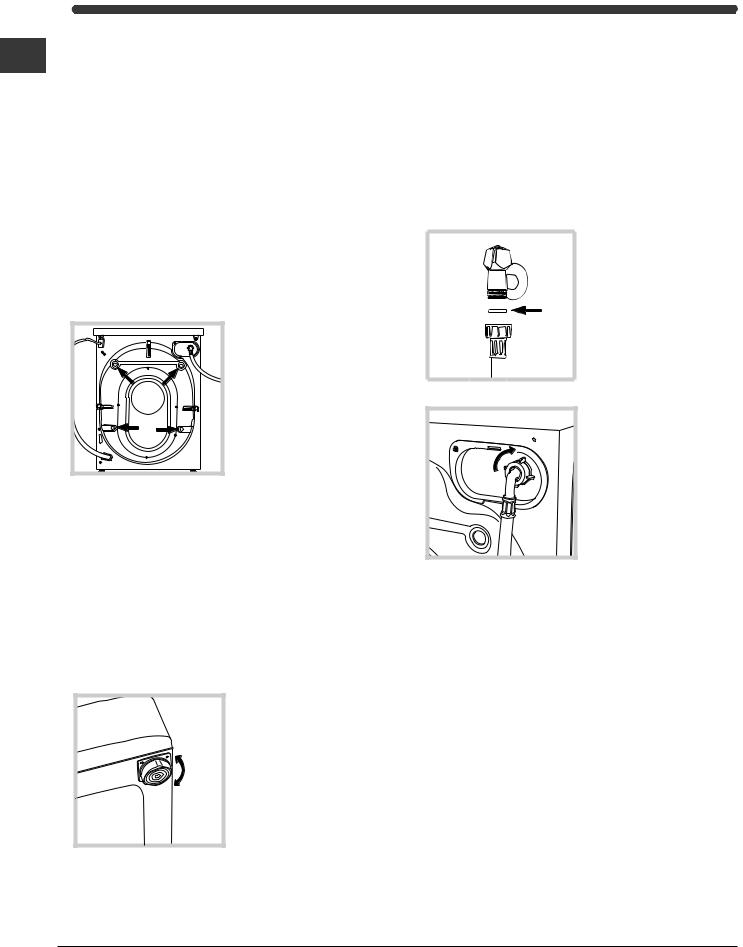
Installation
Keep this instruction manual in a safe place for GB future reference. Should the appliance be sold,
transferred or moved, make sure the instruction manual accompanies the Washer-dryer to inform the new owner as to its operation and features.
Read these instructions carefully: they contain vital information on installation, use and safety.
Unpacking and levelling
Unpacking
1.Unpack the Washer-dryer.
2.Check whether the Washer-dryer has been damaged during transport. If this is the case, do not install it and contact your retailer.
3. Remove the four protective screws and the rubber washer with the respective spacer, situated on the rear of the appliance (see figure).
4.Seal the gaps using the plastic plugs provided.
5.Keep all the parts: you will need them again if the Washer-dryer needs to be moved to another location.
Packaging materials are not children's toys.
Levelling
1. Install the Washer-dryer on a flat sturdy floor, without resting it up against walls, furniture cabinets or other.
2. If the floor is not perfectly level, compensate for any unevenness
by tightening or
loosening the adjustable
front feet (see figure); the angle of inclination, measured according to the worktop, must not exceed 2°.
Levelling your appliance correctly will provide it with stability and avoid any vibrations, noise and shifting during operation. If it is placed on a fitted or loose carpet, adjust the feet in such a way as to allow enough room for ventilation beneath the Washerdryer.
Electric and water connections
Connecting the water inlet hose
1. Insert seal A into the end of the inlet hose and screw the latter onto a cold water tap with a 3/4 gas threaded
A |
mouth (see figure). |
|
|
|
Before making the |
|
connection, allow the |
|
water to run freely until |
|
it is perfectly clear. |
|
2. Connect the other end |
|
of the water inlet hose to |
|
the Washer-dryer, |
|
screwing it onto the |
|
appliance's cold water |
|
inlet, situated on the top |
|
right-hand side on the |
|
rear of the appliance |
|
(see figure). |
3. Make sure there are no kinks or bends in the hose.
The water pressure at the tap must be within the values indicated in the Technical details table
(on the next page).
If the water inlet hose is not long enough, contact a specialist store or an authorised serviceman.
2

Connecting the drain hose
65 - 100 cm |
Connect the drain hose, without bending it, to a draining duct or a wall drain situated between 65 and 100 cm from the floor;
alternatively, place it over the edge of a basin, sink or tub, fastening the duct supplied to the tap (see figure). The free end of the hose should not be underwater.
We advise against the use of hose extensions; in case of absolute need, the extension must have the same diameter as the original hose and must not exceed 150 cm in length.
Electric connection
Before plugging the appliance into the mains socket, make sure that:
•the socket is earthed and in compliance with the applicable law;
•the socket is able to sustain the appliance's maximum power load indicated in the Technical details table (on the right);
•the supply voltage is included within the values i ndicated on the Technical details table
(on the right);
•the socket is compatible with the washing machine's plug. If this is not the case, replace the socket or the plug.
The washing machine should not be installed in an outdoor environment, not even when the area is sheltered, because it may be very dangerous to leave it exposed to rain and thunderstorms.
When the washing machine is installed, the mains socket must be within easy reach.
Do not use extensions or multiple sockets.
The power supply cable must never be bent or dangerously compressed.
The power supply cable must only be replaced by an authorised serviceman.
Warning! The company denies all liability if and when these norms are not respected.
The first wash cycle
Once the appliance has been installed, and before you use it for the first time, run a wash cycle with detergent and no laundry, setting the 90°C programme without a pre-wash cycle.
Technical details
Model |
WIDL 126 S |
||
|
|
||
|
59.5 cm wide |
||
Dimensions |
85 cm high |
||
|
53.5 cm deep |
||
|
|
||
Capacity |
from 1 to 5 kg for the wash programme; |
||
from 1 to 4 kg for the drying programme |
|||
|
|||
|
|
||
Electric |
voltage 220/230 Volts 50 Hz |
||
connections |
maximum absorbed power 1850 W |
||
|
|
||
Water |
maximum pressure 1 MPa (10 bar) |
||
minimum pressure 0.05 MPa (0.5 bar) |
|||
connections |
|||
drum capacity 46 litres |
|||
|
|||
|
|
||
Spin speed |
up to 1200 rpm |
||
|
|
||
|
Wash: programme 2; temperature 60°C; |
||
|
run with a load of 5 kg. |
||
Control |
Drying: first drying cycle performed with |
||
programmes |
a 1 kg load, by selecting a drying time |
||
according to |
of 40 min; |
||
IEC456 directive |
Second drying cycle performed with a 4 |
||
|
kg load and the DRYING knob on |
||
|
the |
setting. |
|
This appliance is compliant with the following European Community Directives:
- 73/23/CEE of 19/02/73 (Low Voltage) and subsequent amendments - 89/336/CEE of 03/05/89 (Electromagnetic Compatibility) and subsequent amendments
- 2002/96/CE
GB
Precautions Detergents Programmes Description Installation
Service Troubleshooting Care
3
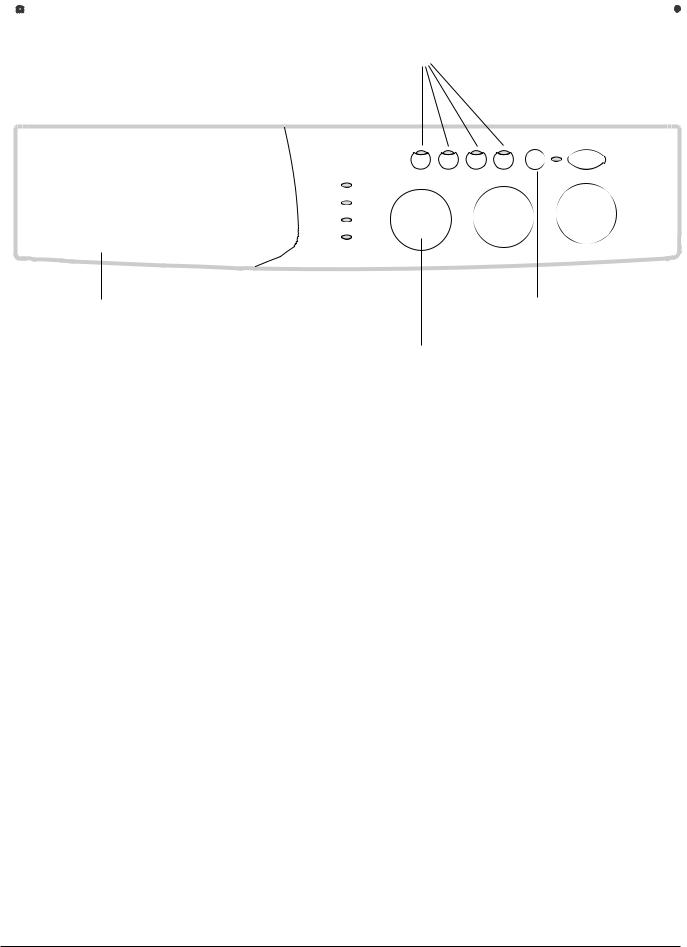
Washer-dryer description
|
|
|
|
|
|
|
|
|
|
|
|
Control panel |
|
|
FUNCTION |
|
|
||||
|
|
|
|
|
||||||
|
|
|
|
|
|
|
||||
GB |
|
|
|
|
Buttons |
|
|
|||
|
|
|
Leds |
|
ON-OFF/ |
|
|
|||
|
|
|
|
|
|
|||||
|
|
|
|
|
|
|
|
|||
|
|
|
|
|
|
|
|
|||
|
|
|
|
|
|
DOOR |
|
ON-OFF |
||
|
|
|
|
|
|
|
||||
|
|
|
|
|
|
LOCK |
|
Button |
||
|
|
|
|
|
|
Led |
|
|
|
|
|
|
|
|
|
|
|
|
|
||
|
|
|
|
|
|
|
|
|
|
|
|
|
|
|
|
|
|
|
|
|
|
|
|
|
|
|
|
|
|
|
|
|
|
|
PROGRAMME |
|
|
|
Detergent dispenser |
|
Knob |
|
||
|
START/RESET |
|
|
Button |
|
DRYING |
TEMPERATURE |
|
Knob |
||
Knob
Detergent dispenser: to add detergent and fabric softener (see page 8).
LEDS: to find out which wash cycle phase is under way.
If the Delay Timer function has been set, the time left until the programme starts will be indicated (see page 5).
DRYING knob: to set the desired drying cycle
(see page 7).
FUNCTION buttons: to select the functions available. The button corresponding to the function selected will remain on.
TEMPERATURE knob: to set the temperature or the cold wash cycle (see page 7).
START/RESET button: to start the programmes or cancel any incorrect settings.
ON-OFF/DOOR LOCK Led: to find out whether the Washer-dryer is on and if the appliance door can be opened (see page 5).
ON/OFF button: to turn the Washer-dryer on and off.
PROGRAMME knob: to select the wash programmes. The knob stays still during the cycle.
4
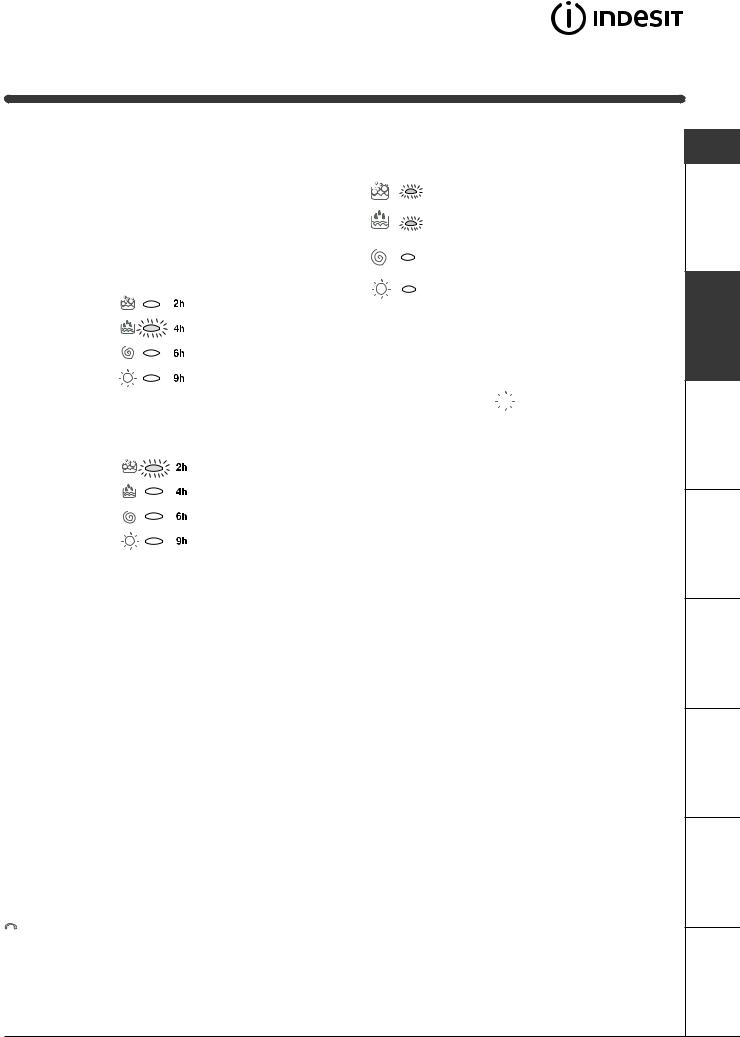
Leds
The LEDS provide important information. This is what they can tell you:
Delay set:
If the Delay Timer function has been enabled (see page. 7), once you have started the programme, the LED corresponding to the delay set will begin to flash:
As time passes, the remaining delay will be displayed, and the corresponding LED will flash:
Once the set delay is complete, the flashing LED will turn off and the programme set will start.
Cycle phase under way:
During the wash cycle, the LEDs gradually illuminate on to indicate the cycle phase under way:
Prewash / Wash
Rinse
Spin cycle
Drying
Note:
-during draining, the LED corresponding to the Spin cycle phase will be turned on.
-when the drying cycle is complete, the indicator
light relative to phase  will flash, to indicate that the DRYING knob needs to be set back to the 0 setting.
will flash, to indicate that the DRYING knob needs to be set back to the 0 setting.
Function buttons
The FUNCTION BUTTONS also act like LEDS. When a function is selected, the corresponding button is illuminated.
If the function selected is incompatible with the programme set, the button will flash and the function will not be enabled.
If you set a function that is incompatible with another function you selected previously, only the last one selected will be enabled.
 ON-OFF/DOOR LOCK led:
ON-OFF/DOOR LOCK led:
If this LED is on, the appliance door is locked to prevent it from being opened accidentally; to avoid any damages, wait for the LED to flash before you open the appliance door.
The rapid flashing of the ON-OFF/DOOR LOCK Led together with the flashing of at least one other LED indicates there is an abnormality. Call for Technical Assistance.
GB
Precautions Detergents Programmes Description Installation
Service Troubleshooting Care
5

Starting and Programmes
Briefly: starting a programme
GB |
1. Switch the Washer-dryer on by pressing button . |
|
|
|
All the LEDS will light up for a few seconds and |
|
the ON-OFF/DOOR LOCK Led will begin to flash. |
2.Load your laundry into the washing machine and shut the appliance door.
3.Set the PROGRAMME knob to the programme required.
4.Set the wash temperature (see page 7).
5.Set the drying cycle if necessary (see page 7).
Programme table
6.Add the detergent and any fabric softener (see page 8).
7.Start he programme by pressing the START/RESET button.
To cancel it, keep the START/RESET button pressed for at least 2 seconds.
8.When the programme is finished, the ON-OFF/ DOOR LOCK Led will flash to indicate that the appliance door can be opened. Take out your laundry and leave the appliance door ajar to allow
the drum to dry thoroughly. Turn the Washer-dryer off by pressing button  .
.
Type of fabric and |
|
Tempe- |
D rying |
D etergent |
Fabric |
Cycle |
|
||
Program. |
|
|
length |
D escription of wash cycle |
|||||
degree of soil |
|
rature |
C ycle |
pre- |
w ash |
softener |
(minutes) |
|
|
|
|
|
|
w ash |
|
|
|
||
|
|
|
|
|
|
|
|
||
Standard |
|
|
|
|
|
|
|
|
|
Extremely soiled whites |
1 |
90°C |
• |
• |
• |
• |
135 |
Pre-wash, wash cycle, rinse cycles, |
|
(sheets, tablecloths, etc.) |
intermediate and final spin cycles |
||||||||
|
|
|
|
|
|
|
|||
Extremely soiled whites |
2 |
90°C |
• |
|
• |
• |
125 |
Wash cycle, rinse cycles, |
|
(sheets, tablecloths, etc.) |
|
intermediate and final spin cycles |
|||||||
|
|
|
|
|
|
|
|||
Heavily soiled whites and fast |
2 |
60°C |
• |
|
• |
• |
110 |
Wash cycle, rinse cycles, |
|
colours |
|
intermediate and final spin cycles |
|||||||
|
|
|
|
|
|
|
|||
|
|
|
|
|
|
|
|
|
|
Heavily soiled whites and delicate |
2 |
40°C |
• |
|
• |
• |
105 |
Wash cycle, rinse cycles, |
|
colours |
|
intermediate and final spin cycles |
|||||||
|
|
|
|
|
|
|
|||
Slightly soiled whites and delicate |
3 |
40°C |
• |
|
• |
• |
70 |
Wash cycle, rinse cycles, |
|
colours (shirts, jumpers, etc.) |
|
intermediate and final spin cycles |
|||||||
|
|
|
|
|
|
|
|||
|
|
|
|
|
|
|
|
|
|
Heavily soiled fast colours |
4 |
60°C |
• |
|
• |
• |
75 |
Wash cycle, rinse cycles, anti-crease |
|
(baby linen, etc.) |
|
or delicate spin cycle |
|||||||
|
|
|
|
|
|
|
|||
|
|
|
|
|
|
|
|
|
|
Heavily soiled fast colours |
4 |
40°C |
• |
|
• |
• |
60 |
Wash cycle, rinse cycles, anti-crease |
|
(baby linen, etc.) |
|
or delicate spin cycle |
|||||||
|
|
|
|
|
|
|
|||
W ool |
5 |
40°C |
|
|
• |
• |
50 |
Wash cycle, rinse cycles anti-crease |
|
|
|
or delicate spin cycle |
|||||||
|
|
|
|
|
|
|
|
||
|
|
|
|
|
|
|
|
|
|
Very delicate fabrics |
6 |
30°C |
|
|
• |
• |
45 |
Wash cycle, rinse cycles, anti-crease |
|
(curtains, silk, viscose, etc.) |
|
|
or draining cycle |
||||||
|
|
|
|
|
|
|
|||
Drying cotton |
7 |
|
• |
|
|
|
|
|
|
|
|
|
|
|
|
|
|
|
|
Drying delicates |
8 |
|
• |
|
|
|
|
|
|
|
|
|
|
|
|
|
|
|
|
Time 4 you |
|
|
|
|
|
|
|
|
|
Heavily soiled whites and fast |
9 |
60°C |
|
|
• |
• |
60 |
Wash cycle, rinse cycles, |
|
colours |
|
|
intermediate and final spin cycles |
||||||
|
|
|
|
|
|
|
|||
Delicate colours |
10 |
40°C |
|
|
• |
• |
40 |
Wash cycle, rinse cycles, delicate |
|
(all types of slightly soiled garments) |
|
|
spin cycle |
||||||
|
|
|
|
|
|
|
|||
Delicate colours |
11 |
30°C |
• |
|
• |
• |
30 |
Wash cycle, rinse cycles and delicate |
|
(all types of slightly soiled garments) |
|
spin cycle |
|||||||
|
|
|
|
|
|
|
|||
|
|
|
|
|
|
|
|
|
|
Sport |
|
|
|
|
|
|
|
|
|
Sports shoes (MAX. 2 pairs) |
12 |
30°C |
|
|
• |
• |
50 |
Cold wash (without detergents), wash |
|
|
|
cycle, rinse cycles, and delicate spin cycle |
|||||||
|
|
|
|
|
|
|
|
||
|
|
|
|
|
|
|
|
|
|
Fabrics for sportswear |
13 |
30°C |
|
|
• |
• |
60 |
Wash cycle, rinse cycles, |
|
(Tracksuits, shorts, etc.) |
|
|
intermediate and final spin cycles |
||||||
|
|
|
|
|
|
|
|||
PARTIAL PROGRAMMES |
|
|
|
|
|
|
|
|
|
Rinse |
|
|
• |
|
|
• |
|
Rinse cycles and spin cycle |
|
|
|
|
|
|
|
|
|
|
|
Spin cycle |
|
|
• |
|
|
|
|
Draining and spin cycle |
|
|
|
|
|
|
|
|
|
|
|
Drain |
|
|
|
|
|
|
|
Drain |
|
|
|
|
|
|
|
|
|
|
|
Notes
-For programme 9, we advise against exceeding a wash load of 3.5 kg. -For programme 13 we advise against exceeding a wash load of 2 kg.
-For the anti-crease function: see Easy iron, opposite page. The information contained in the table is purely indicative.
Special programme
Daily (programme 11 for Synthetics) is designed to wash lightly soiled garments in a short amount of time: it only lasts 30 minutes and allows you to save on both time and energy. By setting this programme (11 at 30°C), you can wash different fabrics together (except for woollen and silk items), with a maximum load of 3 kg.
We recommend the use of liquid detergent.
6
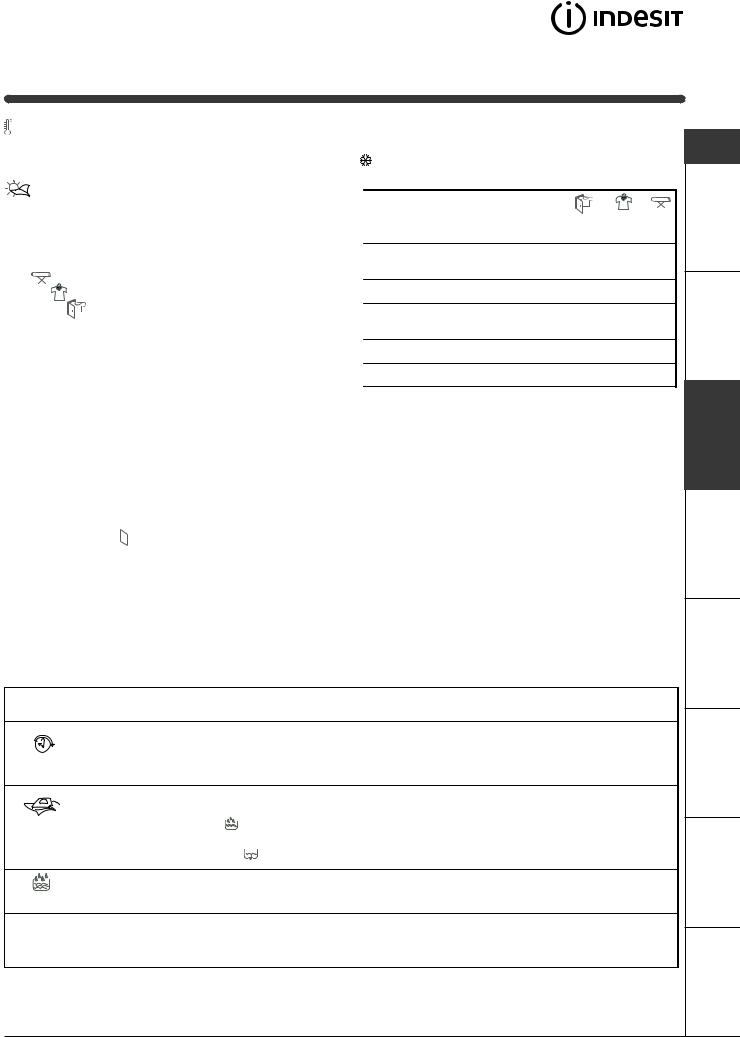
Personalisations
C Setting the temperature
Turn the TEMPERATURE knob to set the wash temperature (see Programme table on page 6). |
|
|
|
||||||||
The temperature can be lowered, or even set to a cold wash ( |
). |
|
|
|
|
The data contained in the |
|||||
|
|
|
|
|
|
|
|
|
|||
|
Set the drying cycle |
Table of drying times |
|
|
table are purely indicative. |
||||||
|
|
Fabric |
|
Load type |
|
Max. |
|
|
|
||
|
|
|
|
|
|
|
|||||
Turn the DRYING knob to set the desired drying type. |
|
|
|
|
|
|
|||||
|
type |
|
|
|
load |
|
|
|
|||
Two options are available: |
|
|
|
|
|
(kg) |
Cup- |
Hanger |
Iron |
||
|
|
|
|
|
|
board |
|
|
|||
|
|
|
|
|
|
|
|
|
|
|
|
A - Based on time: From 40 minutes to 150. |
|
|
|
|
|
|
|
|
|
||
B - Based on the damp level of the dry clothes: |
|
Cotton, |
|
Clothing of different sizes |
|
4 |
130 |
120 |
110 |
||
|
Linen |
|
|
|
|||||||
|
|
|
|
|
|
|
|
|
|
|
|
Iron |
: slightly damp clothes, easy to iron. |
|
|
|
|
|
|
|
|
|
|
Hanger : dry clothes to put away. |
|
Cotton |
|
Terry towels |
|
4 |
130 |
120 |
110 |
||
Cupboard |
: very dry clothes, recommended for towelling |
|
Terital, |
|
Sheets, Shirts |
|
|
|
|
|
|
and bathrobes. |
|
|
|
2,5 |
90 |
80 |
70 |
||||
|
Cotton |
|
|
|
|||||||
A cooling stage is foreseen at the end of the drying cycle. |
|
Acrylics |
|
Pyjamas, socks, etc. |
|
1 |
65 |
60 |
60 |
||
|
|
|
|
|
|
||||||
If your laundry load to wash and dry is exceptionally in excess |
|
Nylon |
|
Slips, tights, stockings, etc. |
|
1 |
65 |
60 |
60 |
||
of the maximum load foreseen (see table opposite), perform |
|
|
|
|
|
|
|
|
|
||
|
|
|
|
|
|
|
|
|
|||
the wash cycle, and when the programme is complete, divide up the garments and put part of them back in the drum. Now follow the instructions provided for a dry only cycle. Repeat this procedure for the remainder of the load.
Dry only
Turn the PROGRAMME knob to one of the drying settings (7-8) depending on the type of fabric, then select the desired drying type using the DRYING knob.
Important: - A spin cycle is carried out during the drying if you have set a cotton programme and a level of dryness (Cupboard  , Hanger
, Hanger  , Iron
, Iron  ).
).
- For cotton loads of less than 1 Kg, use the drying programme designed for delicate fabrics.
Functions
To enable a function:
1.press the button corresponding to the desired function, according to the table below;
2.the function is enabled when the corresponding button is illuminated.
Note: The rapid flashing of the button indicates that the corresponding function cannot be selected for the programme set.
Function |
Effec t |
C om m ents |
Enab led with |
||||
p rogram m es: |
|||||||
|
|
|
|
|
|
||
|
|
|
|
Press th e bu tton repeatedly u ntil the L ED corresponding to th e |
|
||
|
|
|
Delays th e start |
desired delay is turned on . |
A ll |
||
|
|
|
of the wash by |
Th e fifth time the button is pressed, th e function will be disabled. |
|||
|
|
|
up to 9 hours . |
N.B .: Once you h ave pressed th e Start/R eset button, th e delay |
|
||
Delay Timer |
|
can only be decreased if you wish to modify it. |
|
||||
|
|
|
Th is option |
W h en this fun ction is set, programmes 4, 5, 6 w ill end with th e |
|
||
|
|
|
redu ces th e |
|
|||
|
|
|
laundry left to soak (An ti-crease) an d th e R inse cycle ph ase |
3, 4, 5, 6, |
|||
|
|
|
amoun t of |
||||
|
|
|
L ED |
will flash . |
|||
Eas y iro n |
creasing on |
9, 10, |
|||||
- to conclude the cycle, press the STAR T/RESET button ; |
|||||||
|
|
|
fabrics, makin g |
Rinse cycle. |
|||
|
|
|
- to ru n the drain in g cycle alon e, set the kn ob to the relative |
||||
|
|
|
them easier to |
|
|||
|
|
|
symbol |
and press the STAR T/R ESET button . |
|
||
|
|
|
iron . |
|
|||
|
|
|
|
|
|
||
|
|
|
In creases th e |
R ecommended when th e applian ce has a full load or w ith large |
1, 2, 3, 4, 9, |
||
|
|
|
efficiency of the |
10, 12, 13, |
|||
|
|
|
quantities of detergent. |
||||
Ex tra R in s e |
rinse. |
Rinse cycle. |
|||||
|
|
||||||
|
|
|
|
|
|
A ll |
|
|
|
|
R educes th e |
|
|
p rogram m es |
|
|
|
|
spin speed. |
|
|
ex cep t for 6 |
|
12 0 0 -60 0 |
|
|
|
and d raining. |
|||
|
|
|
|
|
|
|
|
GB
Precautions Detergents Programmes Description Installation
Service Troubleshooting Care
7
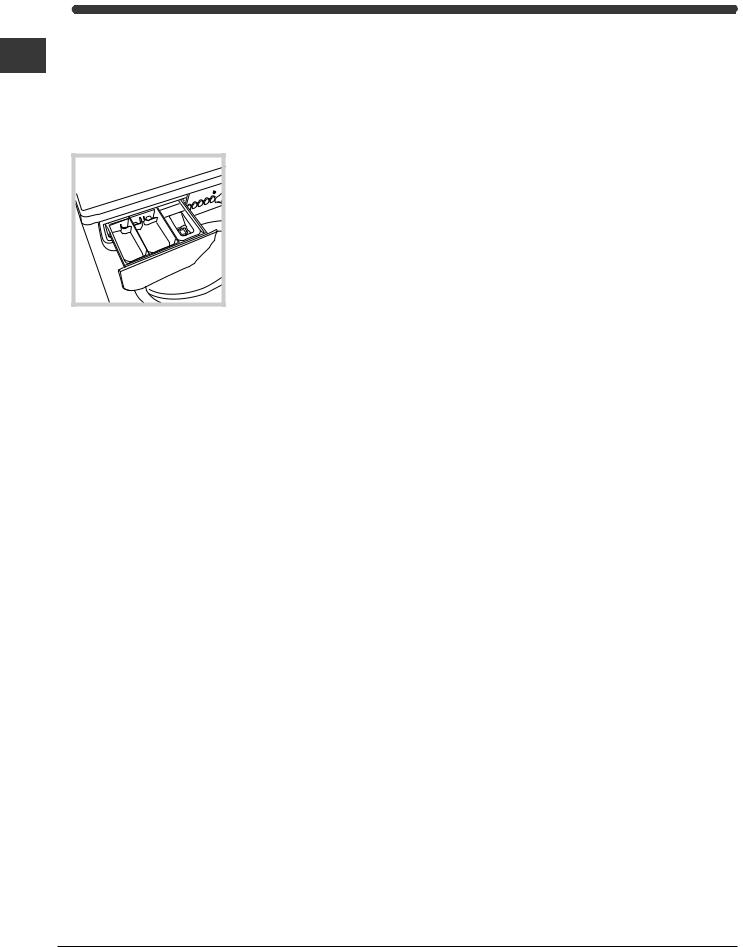
Detergents and laundry
Detergent dispenser
GB |
Good washing results also depend on the correct |
|
|
|
dose of detergent: adding too much detergent won't |
|
necessarily make for a more efficient wash, and may |
|
in fact cause build up on the interior of your |
|
appliance and even pollute the environment. |
|
3 |
1 |
2 |
Open up the detergent dispenser and pour in the detergent and fabric softener, as follows.
compartment 1: Detergent for pre-wash (powder)
compartment 2: Detergent for the wash cycle (powder or liquid)
Liquid detergent should only be poured in immediately prior to the wash cycle start. compartment 3: Additives (fabric softeners, etc.)
The fabric softener should not overflow from the grid.
Do not use hand wash detergent because it may form too much foam.
Special items
Curtains: fold curtains and place them in a pillow case or mesh bag. Wash them separately without exceeding half the appliance load. Use programme 6 which excludes the spin cycle automatically.
Quilted coats and windbreakers: if they are padded with goose or duck down, they can be machine-washed. Turn the garments inside out and load a maximum of 2-3 kg, repeating the rinse cycle once or twice and using the delicate spin cycle. Wool: for best results, use a specific detergent, taking care not to exceed a load of 1 kg.
Preparing your laundry
•Divide your laundry according to:
-the type of fabric/the symbol on the label.
-the colours: separate coloured garments from whites.
•Empty all pockets and check for loose buttons.
•Do not exceed the weight limits stated below, which refer to the weight when dry:
Sturdy fabrics: max 5 kg Synthetic fabrics: max 2.5 kg Delicate fabrics: max 2 kg Wool: max 1 kg
How much does your laundry weigh?
1sheet 400-500 g
1pillow case 150-200 g
1tablecloth 400-500 g
1bathrobe 900-1,200 g
1towel 150-250 g
8
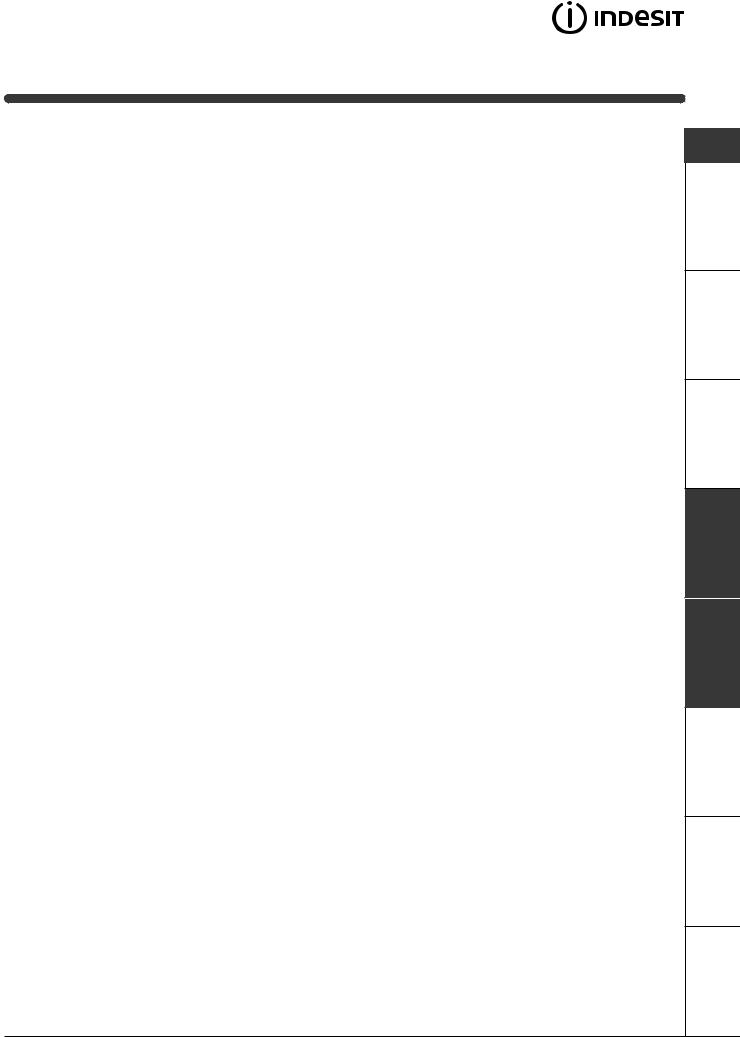
Precautions and advice
The Washer-dryer was designed and built in compliance with the applicable international safety regulations. The following information is provided for your safety and should consequently be read carefully.
General safety
•This appliance has been designed for nonprofessional, household use and its functions must not be changed.
•This washing machine should only be used by adults and in accordance with the instructions provided in this manual.
•Never touch the washing machine when barefoot or with wet or damp hands or feet.
•Do not pull on the power supply cable to unplug the appliance from the electricity socket. Pull the plug out yourself.
•Do not open the detergent dispenser while the appliance is in operation.
•Do not touch the drain water as it could reach very high temperatures.
•Never force the washing machine door: this could damage the safety lock mechanism designed to prevent any accidental openings.
•In the event of a malfunction, do not under any circumstances touch internal parts in order to attempt repairs.
•Always keep children well away from the appliance while in operation.
•The appliance door tends to get quite hot during the wash cycle.
•Should it have to be moved, proceed with the help of two or three people and handle it with the utmost care. Never try to do this alone, because the appliance is very heavy.
•Before loading your laundry into the washing machine, make sure the drum is empty.
•During the drying phase, the door tends to get quite hot.
•Do not use the appliance to dry clothes that have been washed with flammable solvents (e.g. trichlorethylene).
•Do not use the appliance to dry foam rubber or similar elastomers.
•Make sure that the water tap is turned on during the drying cycles.
•This washer-dryer can only be used to dry clothes which have been pre-washed in water.
Disposal
•Disposing of the packaging material:observe local regulations, so the packaging can be re-used.
•The European Directive 2002/96/EC on Waste Electrical and Electronic Equipment, requires that
old household electrical appliances must not be disposed of in the normal unsorted municipal waste stream. Old appliances must be collected separately in order to optimise the recovery and recycling of the materials they contain and reduce the impact on human health and the environment. The crossed out "wheeled bin" symbol on the product reminds you of your obligation, that when you dispose of the appliance it must be separately collected.
Consumers should contact their local authority or retailer for information concerning the correct disposal of their old appliance.
Saving energy and respecting the environment
Environmentally-friendly technology
If you only see a little water through your appliance door, this is because thanks to the latest Indesit technology, your washing machine only needs less than half the amount of water to get the best results: an objective reached to respect the environment.
Saving on detergent, water, energy and time
•To avoid wasting resources, the Washer-dryer should be used with a full load. A full load instead of two half loads allows you to save up to 50% on energy.
•The pre-wash cycle is only necessary on extremely soiled garments. Avoiding it will save on detergent, time, water and between 5 and 15% energy.
•Treating stains with a stain remover or leaving them to soak before washing will cut down the need to wash them at high temperatures. A programme at 60°C instead of 90°C or one at 40°C instead of 60°C will save up to 50% on energy.
•Use the correct quantity of detergent depending on the water hardness, how soiled the garments are and the amount of laundry you have, to avoid wastage and to protect the environment: despite being biodegradable, detergents do contain ingredients that alter the natural balance of the environment. In addition, avoid using fabric softener as much as possible.
•If you use your washing machine from late in the afternoon until the early hours of the morning, you will help reduce the electricity board's peak load. The Delay Timer option (see page 7) helps to organise your wash cycles accordingly.
•If your laundry has to be dried in a tumble dryer, select a high spin speed. Having the least water possible in your laundry will save you time and energy in the drying process.
GB
Precautions Detergents Programmes Description Installation
Service Troubleshooting Care
9
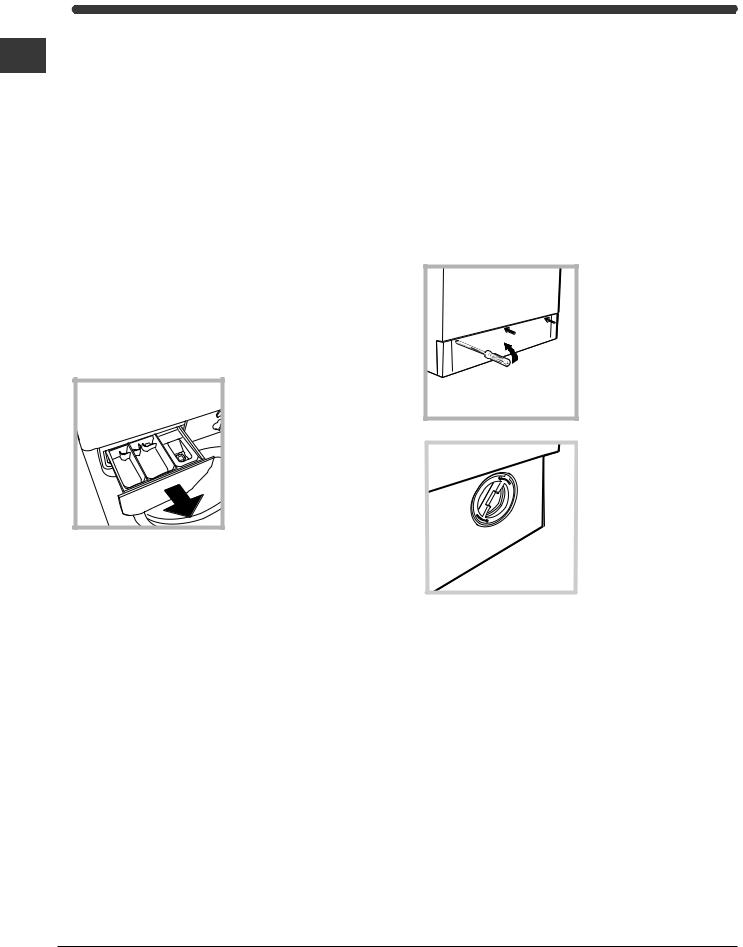
Care and maintenance
Cutting off the water or electricity GB supply
•Turn off the water tap after every wash. This will limit the wear of your appliance's water system and also prevent leaks.
•Unplug your appliance when cleaning it and during all maintenance operations.
Cleaning your appliance
The exterior and rubber parts of your appliance can be cleaned with a soft cloth soaked in lukewarm soapy water. Do not use solvents or abrasives.
Cleaning the detergent dispenser
Remove the dispenser by raising it and pulling it out (see figure).
Wash it under running water; this operation should be repeated frequently.
Caring for your appliance door and drum
•Always leave the appliance door ajar to prevent unpleasant odours from forming.
Cleaning the pump
The Washer-dryer is fitted with a self-cleaning pump that does not require any maintenance. Sometimes, small items (such as coins or buttons) may fall into the pre-chamber that protects the pump, situated in the lower part of the same.
Make sure the wash cycle has ended and unplug the appliance.
To access the pre-chamber:
1. using a screwdriver, remove the cover panel on the lower front of the Washer-dryer (see figure);
2. unscrew the lid rotating it anticlockwise (see figure): a little water may trickle out. This is perfectly normal;
3.clean the interior thoroughly;
4.screw the lid back on;
5.reposition the panel, making sure the hooks are securely in place before you push it onto the appliance.
Checking the water inlet hose
Check the water inlet hose at least once a year. If you see any cracks, replace it immediately: during the wash cycles, water pressure is very strong and a cracked hose could easily split open.
Never use hoses that have already been used.
10
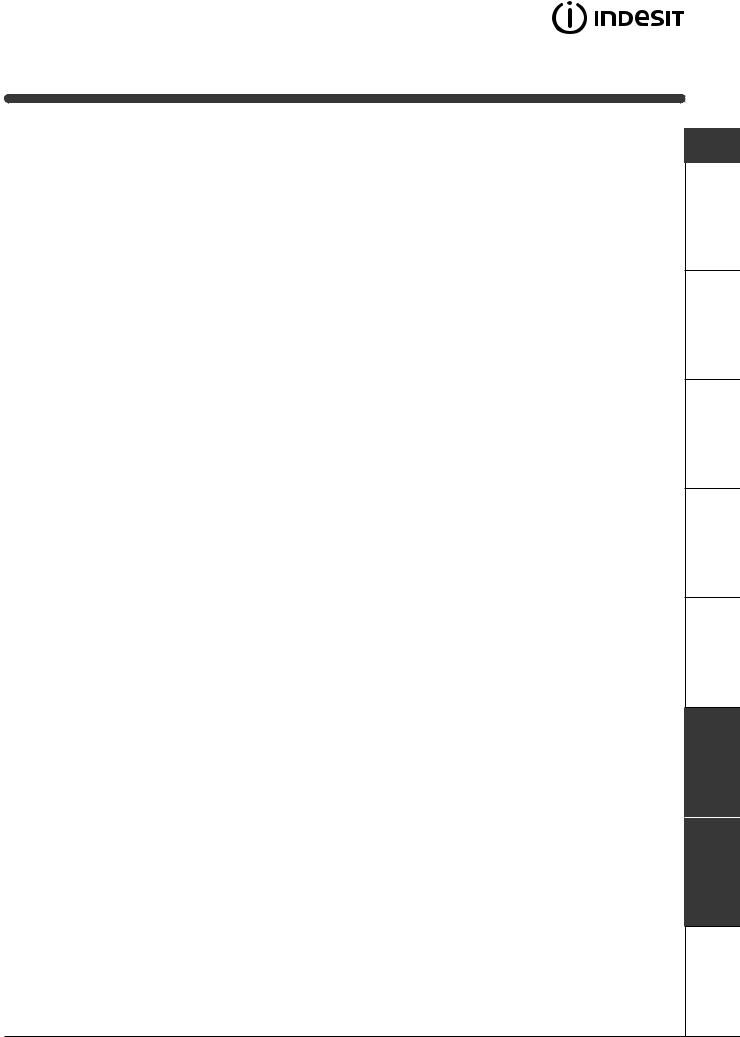
Troubleshooting
Your Washer-dryer could fail to work. Before calling for Assistance (see page 12), make sure the problem can't
easily be solved by consulting the following list. |
GB |
|
Problem
The washer-dryer won't start.
The wash cycle won't start.
The washer-dryer fails to load water.
The washer-dryer continuously loads and unloads water.
The washer-dryer does not drain or spin.
The washer-dryer vibrates too much during the spin cycle.
The washer-dryer leaks.
The ON-OFF/DOOR LOCK Led flashes rapidly at the same time as at least one other LED.
There is too much foam.
The washer-dryer does not dry.
Possible causes/Solution:
•The appliance is not plugged into the socket, or not enough to make contact.
•There has been a power failure.
•The appliance door is not shut properly.
•The  button has not been pressed.
button has not been pressed.
•The START/RESET button has not been pressed.
•The water tap is not turned on.
•A delayed start has been set (using the Delay Timer, see page 7).
•The water inlet hose is not connected to the tap.
•The hose is bent.
•The water tap is not turned on.
•There is a water shortage.
•The water pressure is insufficient.
•The START/RESET button has not been pressed.
•The drain hose is not fitted between 65 and 100 cm from the floor
(see page 3).
•The free end of the hose is underwater (see page 3).
•The wall drainage system doesn't have a breather pipe.
If the problem persists even after these checks, turn off the water tap, switch the appliance off and call for Assistance. If the dwelling is on one of the upper floors of a building, there may be drain trap problems causing the Washer-dryer to load and unload water continuously. In order to avoid such an inconvenience, special anti-drain trap valves are available in shops.
•The programme does not foresee the draining: some programmes require enabling the draining manually (see page 6).
•The Easy iron option is enabled: to complete the programme, press the START/RESET button (see page 7).
•The drain hose is bent (see page 3).
•The drain duct is clogged.
•The drum was not unblocked correctly during installation (see page 2).
•The Washer-dryer is not level (see page 2).
•The Washer-dryer is closed in between furniture cabinets and the wall (see page 2).
•The water inlet hose is not screwed on correctly (see page 2).
•The detergent dispenser is obstructed (to clean it, see page 10).
•The drain hose is not secured properly (see page 3).
•Call for Assistance because this means there is an abnormality.
•The detergent is not suitable for machine washing (it should bear the definition "for washing machines" or "hand and machine wash", or the like).
•You used too much detergent.
•The appliance is not plugged into the socket, or not enough to make contact.
•There has been a power failure.
•The appliance door is not shut properly.
•A delayed start has been set (using the Delay Timer, see page 7).
•the DRYING knob is on the 0 setting.
Precautions Detergents Programmes Description Installation
Service Troubleshooting Care
11

Service
Before calling for Assistance:
GB |
• |
Check whether you can solve the problem on your own (see page 11); |
|
||
|
• |
Restart the programme to check whether the problem has been solved; |
|
• |
If this is not the case, contact an authorised Technical Service Centre on the telephone number |
|
|
provided on the guarantee certificate. |
|
|
Always request the assistance of authorised servicemen. |
Notify the operator of:
•the type of problem;
•the appliance model (Mod.);
•the serial number (S/N).
This information can be found on the data plate situated on the rear of the washer-dryer.
12

Upute za uporabu
|
|
|
PERILICA-SUŠILICA |
||
|
|
|
|
|
|
|
|
|
|
|
|
|
|
|
Pregled |
|
|
|
|
|
HR |
||
|
|
|
|
|
|
|
|
|
Postavljanje, 14-15 |
|
|
|
HR |
|
|
||
|
|
Raspakiravanje i izravnavanje, 14 |
|||
|
|
|
Hidraulièni i elektrièni prikljuèci, 14-15 |
||
|
|
|
|||
|
Hrvatski |
Prvi ciklus pranja, 15 |
|||
|
|
|
Tehnièki podaci, 15 |
||
WIDL 126 S
Opis Perilica-sušilica, 16-17
Kontrolna ploèa, 16
Kontrolna svjetla, 17
Pokretanje i programi, 18
Ukratko: pokrenuti program, 18
Tablica programa, 18
Osobni izbor, 19
Postavljanje temperature, 19
Postavljanje sušenja, 19
Funkcije, 19
Deterdžent i rublje, 20
Pretinac za deterdžent, 20
Pripremanje rublja, 20
Posebno rublje, 20
Mjere predostrožnosti i savjeti, 21
Opæa sigurnost, 21 Uklanjanje, 21
Ušteda i poštivanje okoline, 21
Održavanje i oèuvanje, 22
Zatvaranje vode i iskljuèivanje elektriène struje, 22 Èišæenje Perilica-sušilica, 22
Èišæenje pretinca za deterdžent, 22 Oèuvanje vrata i bubnja, 22 Èišæenje crpke, 22
Provjera cijevi za dovod vode, 22
Nepravilnosti i rješenja, 23
Servisna služba, 24
Prije pozivanja Servisne službe, 24
13
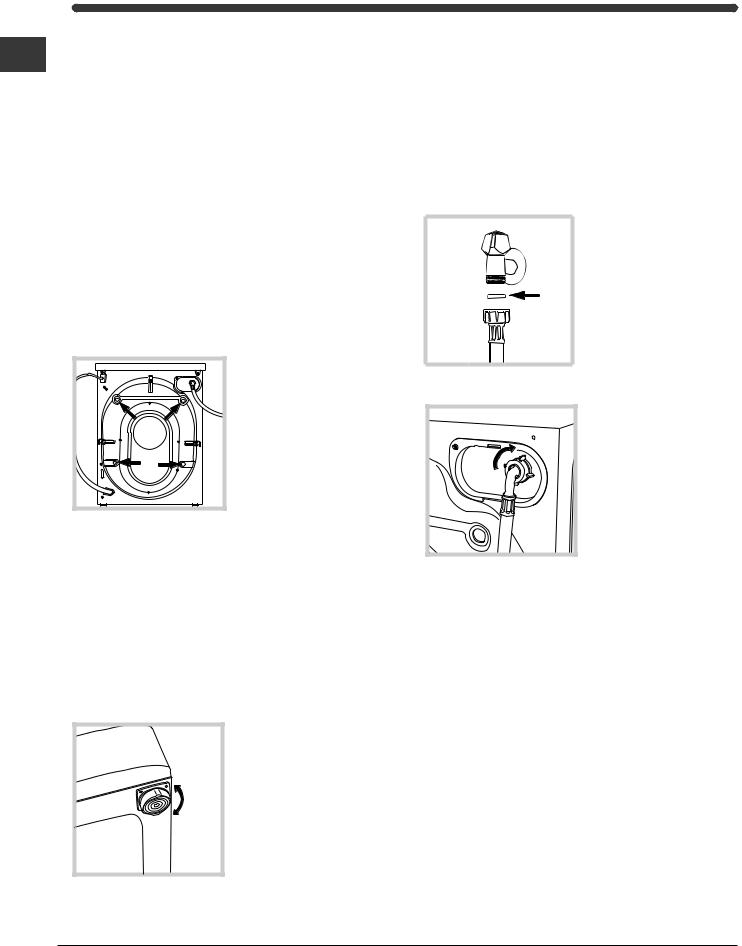
Postavljanje
Važno je saèuvati ove upute kako bi ste ih mogli HR prouèiti u svakom trenutku. U sluèaju prodaje,
ustupanja ili seljenja, provjeriti da se nalaze zajedno s Perilica-sušilica kako bi se novog vlasnika obavijestilo o funkcioniranju stroja i o upozorenjima koja se na njega odnose.
Pozorno proèitajte upute: one sadrže važne obavijesti o postavljanju, uporabi i sigurnosti.
Raspakiravanje i izravnavanje
Raspakiravanje
1.Raspakirajte Perilica-sušilica.
2.Provjerite da Perilica-sušilica nije ošteæena u prijevozu. Ako je ošteæena, nemojte je prikljuèivati i obratite se prodavaèu.
3. Otklonite 4 vijka za zaštitu u prijevozu i gumicu s odstojnikom na stražnjoj strani (vidi sliku).
4.Zatvorite otvore dostavljenim plastiènim èepovima.
5.Saèuvajte sve dijelove: ako je potrebno prevoziti Perilica-sušilica, treba ih ponovno namjestiti.
Pakiranje nije igraèka za djecu.
Izravnavanje
1. Postavite Perilica-sušilica na èvrst i ravan pod i ne naslanjajte je na zidove, namještaj ili drugo.
2. Ako pod nije potpuno vodoravan, nadoknadite razliku u visini odvijanjem ili navijanjem prednjih nožica (vidi sliku); kut nagiba izmjeren na gornjoj površini ne smije prelaziti 2°.
Pomno izravnavanje daje stroju stabilnost i sprijeèava vibracije, buku i pomicanja tijekom rada. U sluèaju da perilicu postavljate na tepison ili sag, podesite nožice tako da ispod Perilica-sušilica ostane dovoljno prostora za protjecanje zraka.
Hidraulièni i elektrièni prikljuèci
Spajanje cijevi za dovod vode
|
1. Umetnite zaptivaè A |
|
na završetak dovodne |
|
cijevi i spojite na |
|
slavinu s hladnom |
A |
vodom 3/4 narezanog |
otvora, kao plinski |
|
|
prikljuèak (vidi sliku). |
|
Prije spajanja pustite |
|
vodu da teèe dok ne |
|
bude bistra. |
2. Spojite dovodnu cijev na Perilica-sušilica navijanjem na odgovarajuæi otvor za uzimanje vode na stražnjoj strani gore desno (vidi sliku).
3. Pazite da na cijevi nema pregiba ni suženja.
Pritisak vode u slavini mora se nalaziti meðu vrijednostima navedenim u tablici Tehnièki podaci
(vidi slijedeæu stranicu).
Ako dužina dovodne cijevi nije dostatna, obratiti se specijaliziranoj prodavaonici ili ovlaštenom tehnièaru.
14
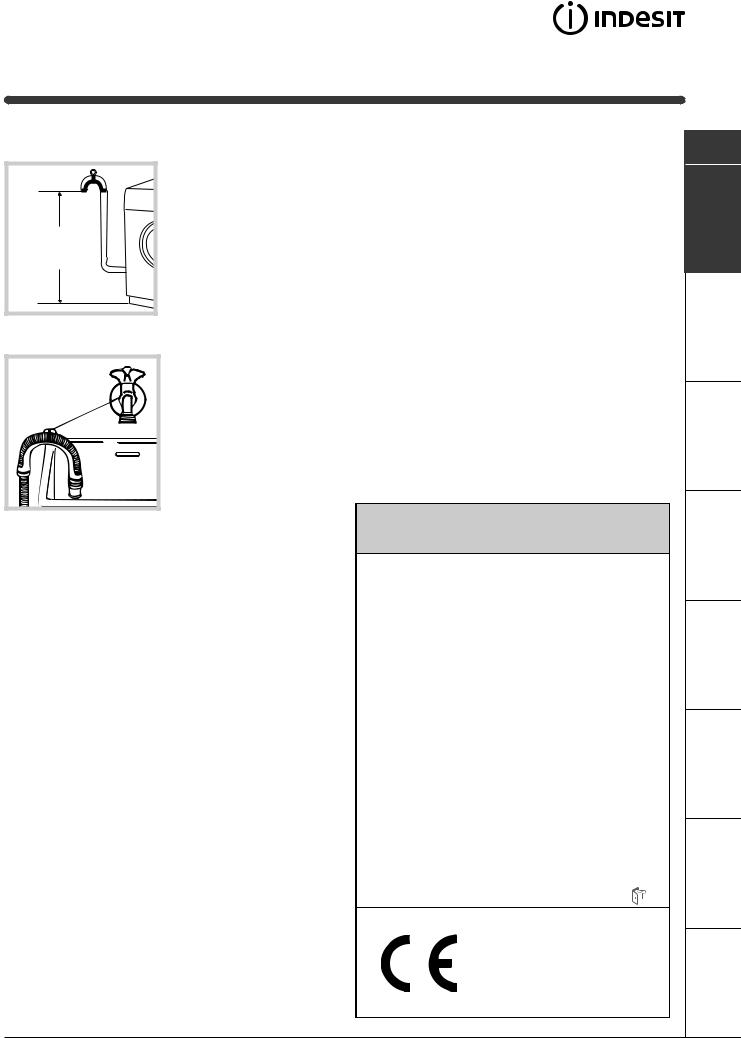
Spajanje cijevi za odvod vode
65 - 100 cm |
Spojite odvodnu cijev ne savijajuæi je, na kanalizaciju ili na odvod u zidu, na visini od 65-100 cm od poda;
ili je naslonite na rub umivaonika ili kade, vezujuæi dostavljeni vodiè za slavinu (vidi sliku). Slobodni završetak odvodne cijevi ne smije ostati uronjen u vodu.
Ne preporuèuje se uporaba produžne cijevi, no ako je neophodna, mora imati isti promjer kao i originalna cijev i ne smije biti duža od 150 cm.
Elektrièni prikljuèak
Prije umetanja utikaèa u utiènicu, provjerite da:
•utiènica ima uzemljenje i da je u skladu sa zakonskim propisima;
•utiènica može podnijeti najveæu snagu stroja naznaèenu u Tehnièkim podacima (vidi tablicu);
•se napon struje nalazi meðu vrijednostima navedenim u tablici Tehnièki podaci (vidi tablicu);
•utiènica odgovara utikaèu Perilica-sušilica. U protivnom, zamijenite utiènicu ili utikaè.
Perilica-sušilica se ne smije instalirati na otvorenom pa ni ako se radi o zaštiæenom prostoru, jer je vrlo opasno izložiti je kiši i nevremenu.
Utiènica mora biti lako dohvatljiva i nakon postavljanja Perilica-sušilica.
Zabranjeno je korištenje produžnih kabela i višestrukih utiènica.
Ne smije se pregibati ili pritiskati kabel.
Elektrièni kabel smiju promijeniti jedino ovlašteni tehnièari.
Pozor! Proizvoðaè otklanja bilo kakvu odgovornost u sluèaju nepoštivanja ovih propisa.
Prvi ciklus pranja
Nakon postavljanja a prije uporabe, izvršiti ciklus pranja s deterdžentom ali bez rublja, postavljajuæi program na 90°C bez pretpranja.
Tehnièki podaci
Model |
WIDL 126 S |
|
|
|
|
|
|
|
širina 59,5 cm |
|
|
Dimenzije |
visina 85 cm |
|
|
|
dubina 53,5 cm |
|
|
|
|
|
|
Kapacitet |
od 1 do 5 kg za pranje; |
|
|
od 1 do 4 kg za sušenje. |
|
||
|
|
||
|
|
|
|
Elektrièno |
napon: 220/230 V 50 Hz |
|
|
prikljuèivanje |
maksimalna utrošena snaga: 1850 W |
|
|
|
|
|
|
Hidraulièno |
maksimalan pritisak: 1 MPa (10 bar) |
|
|
minimalan pritisak: 0,05 MPa (0,5 bar) |
|||
prikljuèivanje |
|||
kapacitet bubnja: 46 l |
|
||
|
|
||
|
|
|
|
Brzina |
do 1200 okretaja u minuti |
|
|
centrifugiranja |
|
||
|
|
||
|
|
||
|
pranje: program 2; temperatura 60°C; |
||
|
izvršeno s 5 kg rublja. |
|
|
Programi kontrole po |
sušenje: prvo sušenje izvršeno s 1 kg |
||
propisu IEC456 |
robe, odabirom vremena od 40 min; |
|
|
|
drugo sušenje izvršeno s 4 kg robe i |
|
|
|
gumbom SUŠENJE na položzaju |
. |
|
Ovaj je ureðaj u skladu sa slijedeæim Uredbama EU:
- 73/23/CEE od 19/02/73
(Nizak pritisak) i naknadnim izmjenama; - 89/336/CEE od 03/05/89 (Elektromagnetska kompatibilnost)
i naknadnim izmjenama
HR
Postavljanje
Opis
Mjere
služba Servisna Nepravilnosti Održavanje predostrožnosti Deterdžent Programi
15
